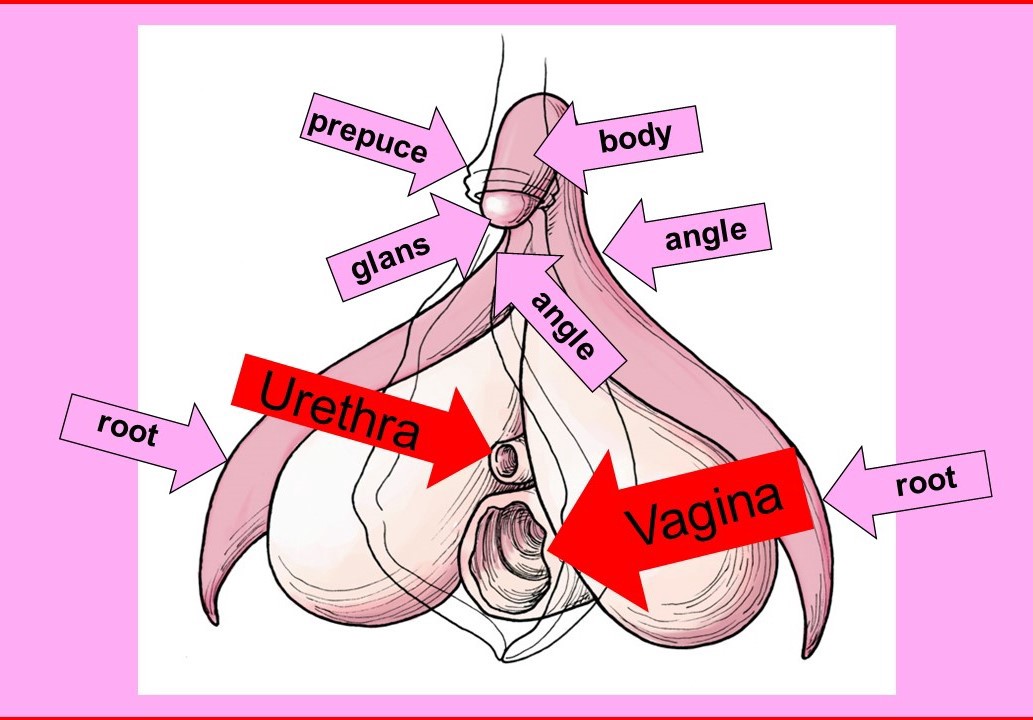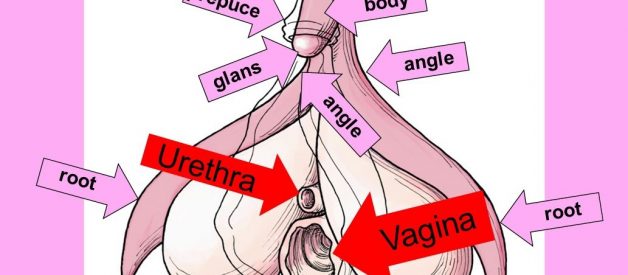The clitoris is by far one of the most difficult sexual topics I have ever written about because of a lack of scientific information about it.
Now don?t get me wrong, there is a lot of ?information? available on the Internet about the clitoris, but most of this information is rooted in something other than reality.
I say this not as a cynic, but as someone who ? without intention ? has been a part of spreading misinformation about the clitoris.
Let me apologize in advance for what I am about to share with you?
Sorry.

One of the obvious and certainly true psychophysical characteristics of the clitoris is its sensitivity. And to demonstrate this, I, as well as the Internet-in-general has cited the nerve innervation of the clitoris to be twice that of the penis ? with there being ?8,000 nerve endings within the clitoris verses only about 4,000 within the penis.?
This statement is not completely false; indeed, the human clitoris is rich with sensory nerve innervation. But this statement isn?t completely true either. The primary reference this statement comes from is a book titled, The Classic Clitoris: Historic Contributions to Scientific Sexuality, by the American Psychiatrist, Thomas Lowry.
The exact numbers Lowry reports is 7,733 ? instead of 8,000 nerve endings for the clitoris; and 4,033 ? instead of 4,000 nerve endings for the penis, when he is describing?cow and sheep clitorises and penises not human clitorises and penises.
My apologies again, I promise in the future to be more discerning with my numbers and species.
The fact of the matter is an exhaustive review of the scientific research literature on the clitoris, fails to yield any study of the complete nerve innervation of the human clitoris.
Simply put, information about the HUMAN clitoris ? that?s rooted in reality ? is parse.
You can demonstrate this yourself by hopping on to the Internet and making a stop at Google Scholar. Google Scholar is a search engine that includes only scientific research studies. Type in the word penis at the Google Scholar prompt and look at how many studies this search yields ? more than 600,000; now type in the word clitoris and look at how many studies this search yields ? only about 60,000.
What this means is scientists are about 10 times more interested in studying penises than clitorises.
We scientifically know the average length of a human penis is about five inches, but with such a lack of relative interest in the clitoris, do we scientifically know the average length of a human clitoris?
To answer this question and fully understand modern-day scientists? interests in penises over clitorises, we must go backward in time nearly 500 years.
First scientifically described in 1545 by the French anatomist, Charles Estienne in his book titled, Dissection Des Parties Du Corps Humain, the clitoris? function was assumed as being associated with urinating.
Various words like gadfly of Venus, Amoris dulcedo, little pillar, and bride have been used throughout history to refer to the clitoris, while the word clitoris itself, was not widely used until the 17th century ? having been derived from Greek words meaning ?hill? and ?to rub.
But regardless of the words used to describe it or the anatomical discoveries about it, throughout the clitoris? history, men have perceived it as something abnormal and needing to be removed.
For example, the French surgical text, Chirurgie Francoise, made popular by Jacques Dalchamps, during the Renaissance, stated this about the clitoris:
??when women find themselves in the company of other women or their clothes rub them while they walk, it erects like a male penis and indeed they use it to play with other women, as their husbands would do?Thus it should be cut off as is described by Aetius.?
Flavius Aetius, was a Roman General, born in 391, who wrote about clitorectomies being common practices dating back to at least the first century BCE.
It wasn?t until the mid-19th century, that the clitoris? anatomy and function were more accurately described by the German anatomist Georg Kobelt.
However, even with Kobelt?s relatively accurate, modern-day scientific descriptions, men of science and medicine continued having clitorises psychologically and physically removed in the name of ?cures? for epilepsy, insanity, catalepsy, and hysteria.
For example, the Father of talk therapy and psychoanalysis, Sigmund Freud argued in his 1905 book, Three Essays on the Theory of Sexuality, that female pleasure and orgasm should be centered on the vagina.
And although Freud was aware many women experienced orgasms through the clitoris, he declared these orgasms as immature and ?infantile.? And said, any woman who could not transfer her center of sensitivity from the clitoris to the vagina was frigid.
The 19th-century medical obstetrician, Isaac Baker Brown took his disdain of the clitoris even further, defending the main thesis of his book titled, The Curability of Certain Forms of Insanity, Epilepsy, Catalepsy, and Hysteria in Females, he argued ??clitoridectomies are justifiable operations?that have been practiced from the time of Hippocrates and have been mentioned by all writers since that period again and again.?
Today, as mentioned, we have more than 60,000 scientific research studies on the clitoris, yet most anatomy and physiology textbooks have incomplete descriptions of the clitoris? functions, and their anatomical descriptions of the clitoris are often only in comparison to the penis.
Today, we scientifically know the sole purpose of the clitoris is for a woman?s pleasure and clitorectomies have no health benefits, yet there are still more than 200 million girls and women alive today who have had clitorectomies.
Today, we know the clitoris is both an external as well as an internal organ. And without controversy, scientists agree, the clitoris is composed of at least five parts.
These five parts include: the prepuce, which partially covers the glans clitoris, the glans clitoris ? also called the head of the clitoris, and the body of the clitoris, which transitions from the glans clitoris.
Each of these first three parts of the clitoris are external, although this varies from one female to the next. For example, some females either only the prepuce or only the glans are visible parts of the clitoris to the naked eye.
The remaining two parts of the clitoris are internal; the body of the clitoris transitions into the angle of the clitoris; and the angle of the clitoris transitions into the root of the clitoris.
Note there is a single body of the clitoris and this transitions into two angles and two roots of the clitoris that surround the vagina.
Part of what makes anatomy complex is that it seems there are thirty different names for the exact same anatomical part. The clitoris? anatomy is no exception to this complexity. For example, the clitoral roots are often referred to as corpus cavernosa. And the ends of the corpus cavernosa are referred to as crura.
And although debatable as being a part of the clitoris, several anatomists include the clitoral bulbs, also referred to as the vestibular bulbs, as the sixth part of the clitoris. The clitoral bulbs transition from the angles of the clitoris and surround the vagina in even closer proximity than the clitoris? roots?.
One more thing needs to be said about the clitoris? anatomy and function:
Today, we know the clitoris is a normal part of a woman?s anatomy with pleasure being its normal physiological function.
To make this clear, let me repeat, the clitoris is a normal part of a woman?s anatomy with pleasure being its normal physiological function.
I?m not sure if I have made myself clear, the clitoris is a normal part of a woman?s anatomy with pleasure being its normal physiological function.
Let?s talk about the details of the clitoris? size.
Because the clitoris is an erectile organ, physiological arousal and excitement affect the size of it; however, a woman?s age, weight, height, or use of oral contraception have no effect on the clitoris? size.
And the normally developed size of the clitoris ? whether it be big or small, fat or thin ? does not affect the potential for a woman to orgasm or the quality of her orgasms.
The diameter of the glans clitoris, ranges between 3 and 8 mm (.1 to .3 inch), the clitoral body, ranges between 1 and 3 cm (.4 to 1.2 inches), and the clitoral roots, range between 12 and 15 cm (4.7 to 6 inches) in length. Adding these numbers together results in an average-size clitoris between 12.7 and 17.8 cm or 5 to 7 inches in length.
So now you know, although often hidden, and psychologically and physically suppressed, the clitoris remains the center of a woman?s pleasure with its size and power being greater than most people realize.
References
Buisson, O., Foldes, P., & Paniel, B.J. (2008). Sonography of the clitoris. Journal of Sexual Medicine, 5, 413?417.
Chalker R. (2000). The Clitoral Truth: The Secret World at Your Fingertips. New York: Seven Stories Press.
Dalechamps, J. (1573). Chirurgie Francoise. Lyon: Guillaume Rouille.
Kobelt, G. L. (1844). Die mannlichen und weibleichn Wollustorgane des Menschen und einiger Saugethiere. Freiburg.
O?Connell, H. E., Sanjeevan, K. V., & Hutson, J. M. (2005). Anatomy of the clitoris. The Journal of Urology, 174, 1189?1195.
Puppo, V. (2013). Anatomy and Physiology of the Clitoris, Vestibular Bulbs, and Labia Minora with a Review of the Female Orgasm and the Prevention of Female Sexual Dysfunction. Clinical Anatomy, 26, 134?152.
World Health Organization (January 31, 2018). Female Genital Mutilation, https://www.who.int/news-room/fact-sheets/detail/female-genital-mutilation
?
Don Lucas is a Professor of Psychology and head of the Psychology Department at Northwest Vista College in San Antonio Texas. He loves psychology, teaching, and research.
If you like this story, then check out Don?s videos on his YouTube channel, 5MIweekly: https://www.youtube.com/channel/UCQFQ0vPPNPS-LYhlbKOzpFw/featured, follow him on Instagram @5MIweekly, and like him on Facebook: http://fb.me/5MIWeekly


